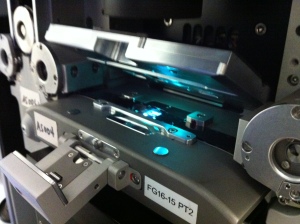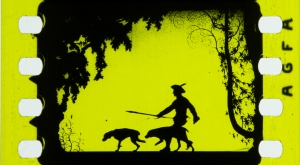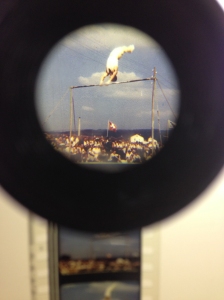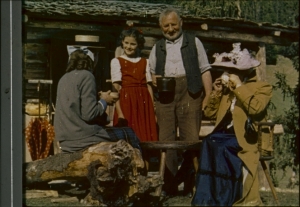- Scanner Study
- Der Märchenwald (1919), a Tinted Silhouette Film
- Technicolor No. V: Switzerland Sportland (1952)
- Dufaycolor: Parures (1939)
- Strategy for the Restoration of the Swiss TV Series Heidi (1978)
- Data Retrieval from the Obsolete DTF Data Tape Format
- Digital Desmet
- Restoring Technicolor: Heidi und Peter (1955)
- Color Analysis for the Digital Restoration of Das Cabinet des Dr. Caligari (1919)
- Early Agfacolor: Immensee (1943) and Opfergang (1944)
- Soundtrack Conservation
- Long-term Storage of Digital Films
- Advanced Tools and Framework for Digital Film Restoration
Showreel:
Print Publications:
- Flueckiger / Op den Kamp / Pfluger (2018): Material-based Approach
- Flueckiger (2015): Caligari
- Trumpy / Flueckiger (2015): Colorimetry and Agfacolor
- Flueckiger / Op den Kamp / Heller / Pfluger (2016): Translating Early Applied Colors
- Batistóva with Flueckiger (2015): Bridging the Gap
- Croci / Aydın / Stefanoski / Markus Gross / Aljoscha Smolic (2017): Advanced Tools and Framework for Historical Film Restoration.
Conference:
Conference Papers and Presentations:
Subsequent Projects:
Case Studies and Reports
Scanner Study
In the course of the project, DIASTOR investigated 7 different high-end scanners with 8 different film stocks. In contrast to previous scanner studies, DIASTOR did not focus primarily on technical quality but rather aimed at studying the scanner–material interaction. The study was continued and completed in the research project FilmColors. An interdisciplinary Approach funded by an Advanced Grant from the European Research Council.
To meet our goals, we devised several steps and areas of investigation with a variety of methods. These included: historical and physical analysis of film stocks; the technical data of the scanners; measurements and objective analyses of image quality (histograms, 1D and 2D Fourier transforms); subjective evaluation of results with a group of subjects; exploration of real-life applications, including the scanner operators’ background and the institutional framework of the scanners in operation.
Various color processes:
We assembled a selection of typical historical film stocks with different material requirements, spectral characteristics, and aesthetic appearance. The spectral absorbance of some of the test materials was measured by Dr. Giorgio Trumpy, a research associate from the DHLab, University of Basel. Stocks encompassed:
- Tinting/toning
- Technicolor IV dye-transfer print
- Kodachrome
- Dufaycolor
- Ektachrome
- B/w reversal
- Faded Eastmancolor positive
- Faded color reversal intermediate
Selection of scanners:
The following scanners were tested at the corresponding facilities:
- DFT Scanity:
- Digimage in Paris, 4K option
- EYE Filmmuseum in Amsterdam (preliminary tests)
- Sound and Vision Hilversum, 2K option
- Northlight:
- Cinegrell Postproduction in Zurich
- ArriScan:
- ARRI Media Munich
- Cinegrell Postproduction Zurich
- Lasergraphics Director:
- Institut National de l’Audiovisuel INA, Paris
- RTI D-Archiver:
- AV Preservation by reto.ch Ecublens
- Sondor ALTRA 2K:
- Sondor Willy Hungerbühler
- Kinetta:
- AV Preservation by reto.ch Ecublens and at Film-Makers’ Cooperative in New York
Report Barbara Flueckiger, David Pfluger, Giorgio Trumpy, Simone Croci, Tunç Aydın, Aljoscha Smolic (2018): Investigation of Film Material–Scanner Interaction. Download PDF (Version 1.1c)
Please always use the link to the DIASTOR results page, we will upload new amended versions here if we discover errors or inconsistencies.
Presentations at the FIAF Conference in Skopje 2014; University of Amsterdam 2014; British Film Institute, in London and in Berkhamsted, GB 2014; AG Restaurierung des Deutschen Kinemethekenverbunds 2016, AG Restaurierung des Deutschen Kinemethekenverbunds 2018.
Der Märchenwald, a Tinted Silhouette Film
DIASTOR restored the German silhouette film Der Märchenwald – Ein Schattenspiel [The Enchanted Forest – A Shadow Play]. The film was directed by Otto Linnekogel and produced in Germany in 1919/1920, several years before Lotte Reiniger’s famous silhouette film Die Abenteuer des Prinzen Achmed (GER 1926). In contrast to Lotte Reiniger’s animated film, Der Märchenwald is a live-action silhouette film with actors playing on a backlit stage.
At DIASTOR partner Cinegrell Postproduction, the tinted nitrate print was scanned on the ARRISCAN in 4K and then color graded based on color references produced photographically from the nitrate print by a calibrated camera set-up with the aid of a software tool for color and style transfer, which was developed by Disney Research Zurich and Swiss Federal Institute of Technology Zurich. The case study was supervised by DIASTOR senior researcher Dr. Claudy Op den Kamp.
The film’s first screening at the Giornate del Cinema Muto in Pordenone was contextualized by a talk on the digital reconstruction of early applied colors, given by DIASTOR manager Prof. Dr. Barbara Flueckiger and Prof. Dr. Ulrich Ruedel, professor at the Hochschule für Technik und Wirtschaft in Berlin.
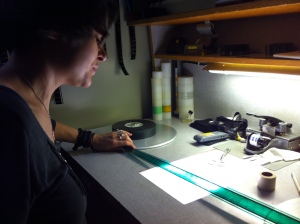
Scanner operator Nicole Allemann inspecting the nitrate print at DIASTOR partner Cinegrell Postproduction’s facility in Zurich
Report by Claudy Op den Kamp: Download PDF
Presentations at the Giornate del Cinema Muto in Pordenone and at the First International Conference Colour in Film in London, GB
Technicolor No. V: Switzerland Sportland (1952)
Switzerland Sportland (USA 1952, André de la Varre), in Technicolor No. V, was provided by Harvard Film Archive. It is part of the program Switzerland in Technicolor, supported by the foundation Memoriav. It was scanned in 4K at DIASTOR partner Cinegrell Postproduction. Originally shot on 16 mm Kodachrome reversal film, the print has a high contrast that made it very demanding for scanning. Due to the fact that the print is on safety stock, the DIASTOR research team was able to capture color references from analog projection in partner Cinegrell Postproduction‘s grading suite, in order to reconstruct the specific Technicolor look and its highly saturated hues.
Report by Claudy Op den Kamp: Download PDF
Dufaycolor: Parures (1939)
Restored in collaboration with the Cinémathèque Suisse, Parures (CH German title: Vom Spinnen und Weben, CH 1939, Werner Dressler) was partly shot using the Dufaycolor line screen process. Due to its diagonal pattern – the so-called réseau in the three additive primaries of red, green and blue – Dufaycolor poses specific problems for scanning. As a result, the DIASTOR research team tested various different workflows in collaboration with the staff at Cinegrell Postproduction. Finally, the team agreed with Cinémathèque Suisse curator Caroline Fournier to use a scan that captured the réseau in focus and to apply a soft blur in postproduction to reconstruct the color appearance of Dufaycolor.
Report by Claudy Op den Kamp: Download PDF
Presentations Il Cinema Ritrovato in Bologna, Italy, 2014; ARRI Archive Workshop in Munich Germany 2014; Reel Thing Conference in Hollywood, Los Angeles, USA 2015; First International Conference Colour in Film in London, GB, 2016
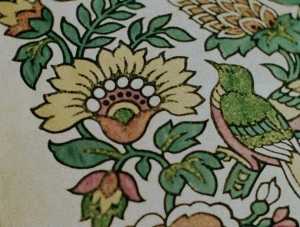
Parures (CH German title: Vom Spinnen und Weben, CH 1939, Werner Dressler). Credit: Cinémathèque suisse
Fragment of the Dufaycolor part from Parures (CH 1939, Werner Dressler),
at DIASTOR partner Cinegrell’s film lab scanned at 4K
and restored including film-out for preservation.
(Please watch in full-screen mode to see the réseau)
Credit: By kind permission of Cinémathèque suisse.
Strategy for the Restoration of the Swiss TV Series Heidi
Several chromogenic film elements were available for the digital restoration of the Swiss TV series Heidi (CH 1978). Each of them was faded differently. In a pilot study, the DIASTOR research team defined a workflow for the color reconstruction based on the approach developed by Franziska Frey and Rudolf Gschwind (1995, 2005) for faded photographs. However, one severe problem for this task was the lack of versatility and modularity of currently available scanners. It was not possible to adjust the spectral range of the scanners’ illumination narrowly to the absorption maxima of the film stocks, as required by Frey/Gschwind’s approach. Despite this limitation, it was possible to develop a satisfactory solution based on the comparison of the different elements. Further investigations will be necessary and will be executed in the framework of the new research project ERC Advanced Grant Film Colors.
Report: Powerpoint slides by David Pfluger
Presentations Il Cinema Ritrovato in Bologna, Italy, 2014; ARRI Archive Workshop 2014.
Data Retrieval from the Obsolete DTF Data Tape Format
Markus Imhoof’s Oscar nominated film Das Boot ist voll (CH 1981) was restored in 2003. This digitization in high definition was stored on DTF tapes, a proprietary and now obsolete format. The case study aimed at investigating the necessary steps for data retrieval from an obsolete format.
Report by David Pfluger (completed, under review)
Presentations Il Cinema Ritrovato in Bologna, Italy, 2014; ARRI Archive Workshop 2014.
Interview with Swiss director Markus Imhoof (in German) on why he lost his oscar-nominated film almost twice and why we need research on film digitization and long-term storage.
Digital Desmet
Early applied colors, such as tinting and toning, have remained difficult to digitize to this day. DIASTOR organized various workshops with partners from the Netherlands – such as EYE Filmmuseum and Haghefilm Digitaal, both in Amsterdam, and Sound and Vision in Hilversum – and with scanner operator Markus Mastaller from ARRI in Munich in collaboration with Cinegrell Postproduction. Inspired by input from experts Martin Koerber and Giovanna Fossati, provided as feedback in the mid-project DIASTOR workshop, the research team developed a workflow called Digital Desmet Plus. This combines information retrieval in the scanning process that is optimized according to the material properties of the film stock with the application of the RestoGUI color and style transfer tool developed by DIASTOR researchers from Disney Research Zurich and the Swiss Federal Institute of Technology in Zurich.
Publication: Flueckiger, Barbara; Heller, Franziska; Pfluger, David; Op den Kamp, Claudy (2016): “Digital Desmet”. Translating Early Applied Colors. In: Tami Williams (ed.): Moving Image, 16,1, pp. 106-124. Download on Project MUSE
Presentations: Conference The Colour Fantastic: Chromatic Worlds of Silent Cinema, EYE Film Institute, Amsterdam, Netherlands; First International Conference Colour in Film in London, GB, 2016.
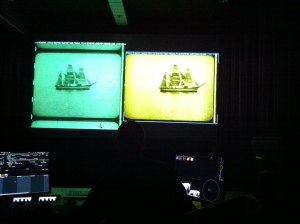
Side by side comparison of scans (left) with reference images (right) in the color grading suite at Cinegrell postproduction.
Color and style transfer software: Images from the raw scan (top left in each of these four-cell arrays) are adjusted semi-automatically to a color reference (top right), “difference image” (bottom left), and adjusted image (bottom right). Tool developed by Swiss Federal Institute of Technology Zurich.
See also article Reproducing Film Colors, and Their Significances by Peter Monaghan for Moving Image Archive News.
Restoring Technicolor: Heidi und Peter
The first Swiss Technicolor feature film, Heidi und Peter (CH 1955), was produced on Technicolor No. V. The Eastmancolor camera negative and several Technicolor prints survived, but the only black-and-white separations extant are of the second reel. The rest were discarded due to a human error in the early 2000s. A global search for further elements is still in progress; therefore this restoration is not yet complete. The restoration has been commissioned by SRF Swiss Radio and Television and will be executed in collaboration with DIASTOR partners Cinémathèque Suisse and Cinegrell Postproduction. The research team elaborated a workflow based on a thorough material analysis of the various dye transfer prints in collaboration with research associate Dr. Giorgio Trumpy. The workflow combines scans from the camera negative with the look of the dye-transfer prints through the application of the software tool RestoGUI developed by DRZ/ETHZ. Heidi und Peter will be part of the program Switzerland in Technicolor, supported by Memoriav.
Report: Powerpoint slides by Barbara Flueckiger Download
Presentation Berlinale Retrospective Glorious Technicolor in Berlin, Germany
Color Analysis for the Digital Restoration of Das Cabinet des Dr. Caligari (GER 1919)
The world-famous German expressionist film Das Cabinet des Dr. Caligari was restored from 2013 to 2014 by the Friedrich Wilhelm Murnau Foundation in collaboration with L’Immagine ritrovata in Bologna. DIASTOR documented all the known surviving tinted and toned nitrate positives which were collected for the restoration. A series of methods were applied to identify the pigments and dyes, such as x-ray fluorescence, Raman spectroscopy, laser ablation inductively coupled plasma mass spectrometry, spectrophotometry. In addition, experiments with a variety of different types of illumination were executed to investigate the color appearance in projection light.
Publication Flueckiger, Barbara (2015): Color Analysis for the Digital Restoration of Das Cabinet des Dr. Caligari. In: Joshua Yumibe (ed:): Moving Image, 15,1, pp. 22–43. Link to download
Gallery of the photographically documented nitrate prints on the Timeline of Historical Film Colors.
Presentations AMIA Reel Thing Conference in Richmond VA, USA 2013; AG Restaurierung des Deutschen Kinemathekenverbunds, Berlin, Germany, 2013; University of Amsterdam 2014.
Das Cabinet des Dr. Caligari: Comparison restoration 1984 with 2014, Murnau-Stiftung, Wiesbaden.
Restoration (2014): Copyright: Friedrich-Wilhelm-Murnau-Stiftung, Wiesbaden.
Digital restoration: L’Immagine Ritrovata — Film Conservation & Restoration, Bologna.
Agfacolor Study
In a subsequent project, the Friedrich Wilhelm Murnau Foundation, under the supervision of Anke Wilkening, restored the two early Agfacolor films – Opfergang (1944) und Immensee (1943) – in collaboration with ARRI in Munich. As the first chromogenic negative–positive process, Agfacolor was as prone to color fading as the subsequently introduced Eastmancolor process. A statistical analysis of the film elements showed that the spectral characteristics of the dyes were shifted to the long-wave area compared to more recent chromogenic film stocks. Therefore, it is not possible to scan the film material selectively at the absorption peaks. As a result, DIASTOR elaborated an alternative approach to the restoration of the color appearance, which relies on a comprehensive study of primary technical sources and additional aesthetic analyses.
Report by Barbara Flueckiger and Giorgio Trumpy (completed, update February 2017: disclosed due to a paper publication)
Publication Trumpy, Giorgio; Flueckiger, Barbara (2015): Light Source Criteria for Digitizing Color Films. In: Proceedings of the Colour and Visual Computing Symposium 2015, CVCS, Gjøvik Norway, August 2015, IEEE 2015. Link to download
Presentations Reel Thing Conference in Hollywood, Los Angeles, USA, First International Conference Colour in Film in London, GB; ARRI Archive Workshop 2016 in collaboration with Anke Wilkening, Friedrich Wilhelm Murnau Foundation, Thilo Gottschling, ARRI Munich; AG Restaurierung des Deutschen Kinemathekenverbunds in Berlin 2014.
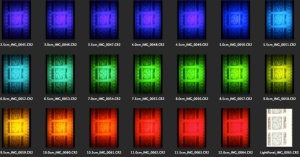
Principal Component Analysis of the Agfacolor negative, executed by Giorgio Trumpy and Barbara Flueckiger
Soundtrack Conservation
From the beginning of the project, DIASTOR partner Cinémathèque Suisse expressed the wish that the research team would search for a solution for the long-term storage of soundtracks. While it is possible to store digital image data on film, this solution is not very suitable for soundtrack conservation for a variety of reasons. However, it is not reasonable to develop an approach single-handedly because two of the core requirements for film conservation are their wide-spread adoption and open standards. As a result, DIASTOR assembled a critical overview on all the currently possible solutions, which will facilitate archives’ decision making processes.
Report by David Pfluger (completed, under review)
Long-term Storage of Digital Films
Similarly, there is a lack of universal standards for the long-term storage of digital films. Starting in 2013, DIASTOR has executed a qualitative study, to gather an overview on the practices in national film archives in Europe and some archives in the US. The resulting report summarizes these practices with the aim of providing a resource for practitioners in archives and the film industry and for political decision makers.
Report by Franziska Heller online.
Presentations: Zürich für den Film, Zurich 2013; Conference by the initiative Filmerbe in Gefahr Die Rettung des Filmerbes und die Fachwissenschaften in Frankfurt am Main, Germany 2015.
Advanced Tools and Framework for Digital Film Restoration
Digital restoration of historically valuable film content is crucial for the preservation of cultural heritage. Such digital restoration is not only a relevant application area for various video processing technologies that have been developed in computer graphics literature, but also involves a multitude of unresolved research challenges. Currently, the digital restoration workflow is highly labor intensive and often relies heavily on expert knowledge. In this paper, we revisit some key steps of this workflow and propose novel, semi-automatic methods for performing them. To do that we build upon state-of-the-art video processing techniques by adding the components necessary for enabling (i) restoration of chemically-degraded colors of the film stock, (ii) removal of excessive film grain through spatiotemporal filtering, and (iii) contrast recovery by transferring contrast from the negative film stock to the positive. We show that, when applied individually, our tools produce compelling results, and when applied jointly they improve the degraded input content significantly. Building on a conceptual framework of film restoration ensures the best possible combination of tools and use of available materials.
Paper published by Simone Croci, Tunç Aydın, Nikolce Stefanoski, Markus Gross, Aljoscha Smolic (2017): Advanced Tools and Framework for Historical Film Restoration. In: Journal of Electronic Imaging, 26.1, 011021 (2017), doi: 10.1117/1.JEI.26.1.011021
Publications
Flueckiger, Barbara; Op den Kamp, Claudy; Pfluger, David (2018, in press): A Material-Based Approach to the Digitization of Early Film Colors. In: Giovanna Fossati, Victoria Jackson, Bregt Lameris, Elif Rongen, Sarah Street, and Joshua Yumibe (eds.): The Colour Fantastic. Chromatic Worlds of SIlent Cinema. Amsterdam: Amsterdam University Press , pp. 237–259 (peer-reviewed). Link to publisher’s website
Flueckiger, Barbara (2015): Color Analysis for the Digital Restoration of Das Cabinet des Dr. Caligari. In: Joshua Yumibe (ed:): Moving Image, 15,1, pp. 22–43. Link to download
Trumpy, Giorgio; Flueckiger, Barbara (2015): Light Source Criteria for Digitizing Color Films. In: Proceedings of the Colour and Visual Computing Symposium 2015, CVCS, Gjøvik Norway, August 2015, IEEE 2015. Link to download
Flueckiger, Barbara; Heller, Franziska; Pfluger, David; Op den Kamp, Claudy (2016): “Digital Desmet”. Translating Early Applied Colors. In: Tami Williams (ed.): Moving Image, 16,1, pp. 106-124. Download on Project MUSE
Anna Batistová with Barbara Flueckiger (2015): Překlenout propast mezi analogovými dějinami filmu a digitální technologií. Rozhovor s Barbarou Flueckigerovou. In: Iluminace, No. 2, 2015, pp. 73–82. (in Czech) (English original: Bridging the Gap Between Analog History of Film and Digital Technologies) Link to download
Simone Croci, Tunç Aydın, Nikolce Stefanoski, Markus Gross, Aljoscha Smolic (2017): Advanced Tools and Framework for Historical Film Restoration. In: Journal of Electronic Imaging, 26.1, 011021 (2017), doi: 10.1117/1.JEI.26.1.011021. Link to download
DIASTOR Conference in Zurich, June 5, 2014
Please consult the DIASTOR Conference page for details, program and downloads. A short report on the conference is available here.
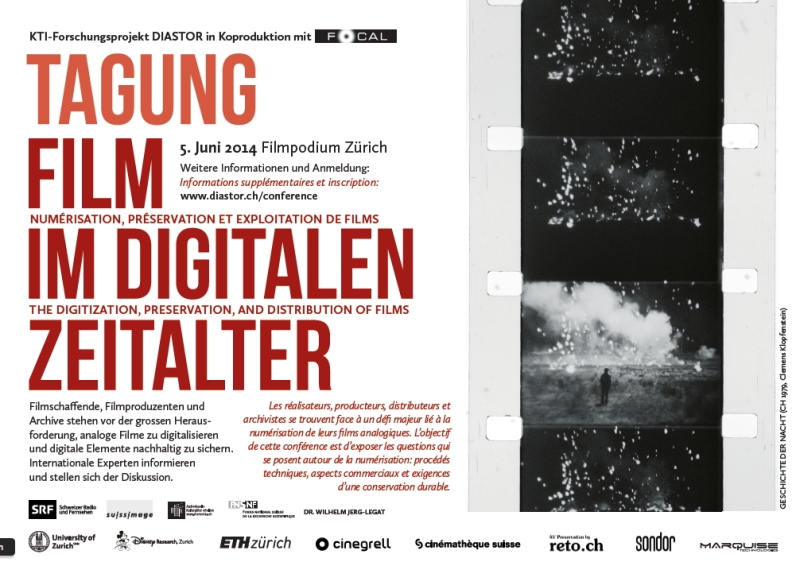
Flyer for the DIASTOR Conference in Zurich, 2014
Conference Proceedings and Presentations
Flueckiger, Barbara: Keynote “Bridging the Gap between Analogue Film History and Digital Technology”. First International Conference Colour in Film in London, GB
Flueckiger, Barbara: “Film Color Restoration Case Studies”. First International Conference Colour in Film in London, GB
Flueckiger, Barbara: “FilmColors. An Interdisciplinary Approach”. Department of Psychological Sciences, Birkbeck, University of London, GB
Flueckiger, Barbara: “DIASTOR Scannertests”. Conference of the AG Restaurierung des Deutschen Kinemathekenverbunds, Berlin, Germany
2015
Pfluger, David: “DIASTOR Scanner Tests” at the Newsreel and Documentary Film Archive, Graduate Institute of Studies in Documentary and Film Archiving, Tainan National University of the Arts, Tainan, Taiwan
Flueckiger, Barbara: “A Digital Humanities Approach to Film Colors”, Conference Moving Image Analytics: Research Infrastructure for Film Heritage in Stockholm, Sweden
Flueckiger, Barbara: Verschwindet unserer Filmgeschichte? Conference by the initiative Filmerbe in Gefahr Die Rettung des Filmerbes und die Fachwissenschaften in Frankfurt am Main, Germany
Flueckiger, Barbara (with Ulrich Ruedel, HTW Berlin): Films Were Always Colored, Collegium of the Giornate del Cinema Muto, Pordenone, Italy
Flueckiger, Barbara: “DIASTOR’s Approach to Restoring Film Colors”. Reel Thing Conference in Hollywood, Los Angeles, USA
Pfluger, David; Op den Kamp, Claudy, Flueckiger, Barbara: “How to Bake a Medieval Chocolate Cake”, “Testing ‘Digital Desmet’” and “Creating a Color Reference”. Conference The Colour Fantastic: Chromatic Worlds of Silent Cinema, EYE Film Institute, Amsterdam, Netherlands
Flueckiger, Barbara: “A Material Approach to Film Restoration”. British Film Institute National Archive, JP Getty Conservation Centre Berkhamsted GB
Flueckiger, Barbara: “Filmfarben und Filmrestaurierung”. Bundesarchiv Filmarchiv in Hoppegarten, Berlin, Germany
Flueckiger, Barbara: “Challenges and Opportunities in Restoring Technicolor”, with Schawn Belston (Twentieth Century Fox), Paolo Cherchi Usai (senior curator of the Moving Image Department, George Eastman House) and Ulrich Ruedel (analytical chemist and film restorer) hosted by Martin Koerber, director of the archive at Deutsche Kinemathek, Berlinale Retrospective Glorious Technicolor in Berlin, Germany
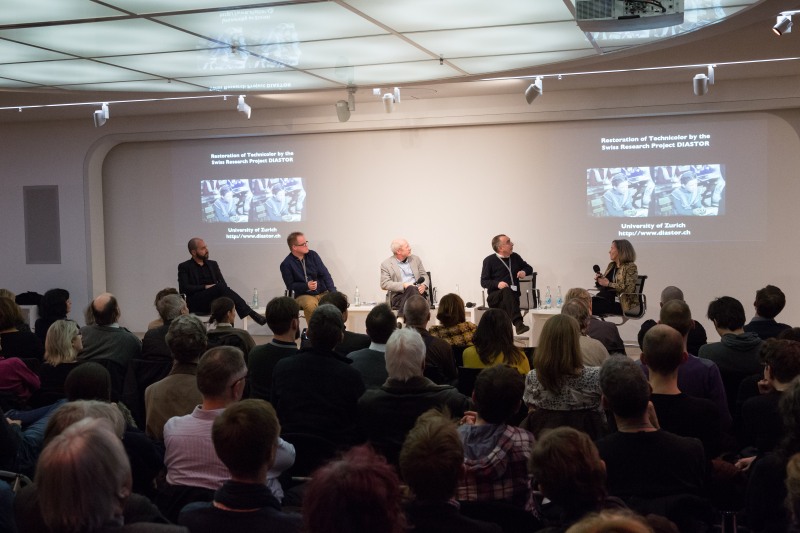
Berlinale Retro 2015. Photo © Sandra Weller
Flueckiger, Barbara: “Technicolor und Filmrestaurierung” at the Jahrestagung der AG Restaurierung des Deutschen Kinemathekenverbunds in Berlin, Germany
Flueckiger, Barbara: Panel discussion “Droht dem Schweizer Film die digitale Enterbung?” Solothurner Filmtage, with Frédéric Maire, Director Cinémathèque suisse, Christoph Stuehn, Director Memoriav, Irène Challand, RTS, Fernand Melgar, Director, Climage, Gérard Ruey, Producer CAB Production, SUISSIMAGE in Solothurn, Switzerland Link to newspaper article
2014
Flueckiger, Barbara: “Digitaler Roll-out. Wie die Digitalisierung unsere Wahrnehmung von Filmen verändert”. International lecture series Mediale Erfahrungen des Fremden, mediale Konstruktionen des Eigenen, Johannes-Gutenberg-Universität, in Mainz, Germany
Pfluger, David; Op den Kamp, Claudy; Flueckiger, Barbara: “Chronology of Film Colors and DIASTOR”. FIAF Summer School, Il Cinema Ritrovato in Bologna, Italy
Flueckiger, Barbara: Opening Presentation at the DIASTOR Conference “Film im digitalen Zeitalter. Filme digitalisieren, sichern und bewirtschaften” DIASTOR, Filmpodium Zurich, Switzerland
Pfluger, David; Op den Kamp, Claudy, Flueckiger, Barbara: “Bridging the Gap Between Film History and Technology. The Swiss Research Project DIASTOR”. ARRI Archive Workshop in Munich, Germany
Flueckiger, Barbara: “DIASTOR Scanner Tests”. FIAF Technical Commission Workshop, FIAF Congress Skopje, Macedonia
Flueckiger, Barbara: “Research on Film Colors and Material/Scanner Interaction”, British Film Institute, in London and in Berkhamsted, GB
Flueckiger, Barbara: “At the Threshold Between Humanities and Science. The Technobole Approach”. University of Amsterdam, Netherlands
2013
Flueckiger, Barbara: “Timeline of Historical Film Colors, DIASTOR and Color Analysis for CALIGARI”. AMIA Reel Thing Conference in Richmond VA, USA
Heller, Franziska: “How the Digitization of Films is Shaping History” and Flueckiger, Barbara: “DIASTOR: Building a National Network for the Digitization of Archival Films”, two panels #1: Ethics, Issues and Opportunities and Digitisation and Archives; #2: Strategies, Politics, and Cultural Context. NECS conference in Prague
Flueckiger, Barbara: “Creating an Online Repository for Film Colors”. ARRI Archive Workshop, Munich, Germany
Flueckiger, Barbara: “KTI-Forschungsprojekt DIASTOR Bridging the Gap Between Analog Film History and Digital Technology”. Conference Memoriav meets Humanities Die Digital Humanities und Das Audiovisuelle Kulturgut in Neuchâtel, Switzerland
Flueckiger, Barbara: “Langzeitarchivierung von digitalen Filmen”. Zürcher Filmtalk, Zurich, Switzerland
Flueckiger, Barbara: “DIASTOR und die Farbanalyse von Caligari”. AG Restaurierung des Deutschen Kinemathekenverbunds, Berlin, Germany
Subsequent Projects
ERC Advanced Grant FilmColors: In 2015, the European Research Council awarded the prestigious Advanced Grant to DIASTOR project leader Prof. Dr. Barbara Flueckiger. Together with a team of researchers and PhD students, Flueckiger investigates the relationship between film color aesthetics and technology, including physico-chemical analyses and new approaches to the digitization and restoration of films.
SNSF Filmfarben: In addition and complementary to the ERC Advanced Grant, the Swiss National Science Foundation has funded a research project that investigates the cultural and institutional context of film colors and their technical development.
Spin-off Dr. David Pfluger: For consulting on your digitization or restoration projects please get in touch with David Pfluger.

